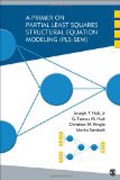
A primer on partial least squares structural equation modeling (PLS-SEM)
Hair, Joseph
Hult, G. Tomas M.
Ringle, Christian M.
Sarstedt, Marko
PLS-SEM is evolving as a statistical modeling technique and its use has increased exponentially in recent years within a variety of disciplines, due to the recognition that PLS-SEM's distinctive methodological features make it a viable alternative to the more popular covariance-based SEM approach. This text-the only comprehensive book available to explain the fundamental aspects of the method-includes extensive examples on SmartPLS software, and is accompanied by multiple data sets that are available for download from the accompanying website (www.pls-sem.com). INDICE: Chapter One: Structural Equation ModelingChapter Two: Specifying the Path Model and Collecting DataChapter Three: Path Model EstimationChapter Four: Assessing PLS-SEM Results Part I: Evaluation of Reflective Measurement ModelsChapter Five: Assessing PLS-SEM Results Part II: Evaluation of the Formative Measurement ModelsChapter Six: Assessing PLS-SEM Results Part III: Evaluation of the Structural ModelChapter Seven: Advanced Topics in PLS Path ModelingChapter Eight: Modeling Heterogeneous Data
- ISBN: 978-1-4522-1744-4
- Editorial: SAGE
- Encuadernacion: Rústica
- Páginas: 328
- Fecha Publicación: 14/05/2013
- Nº Volúmenes: 1
- Idioma:
